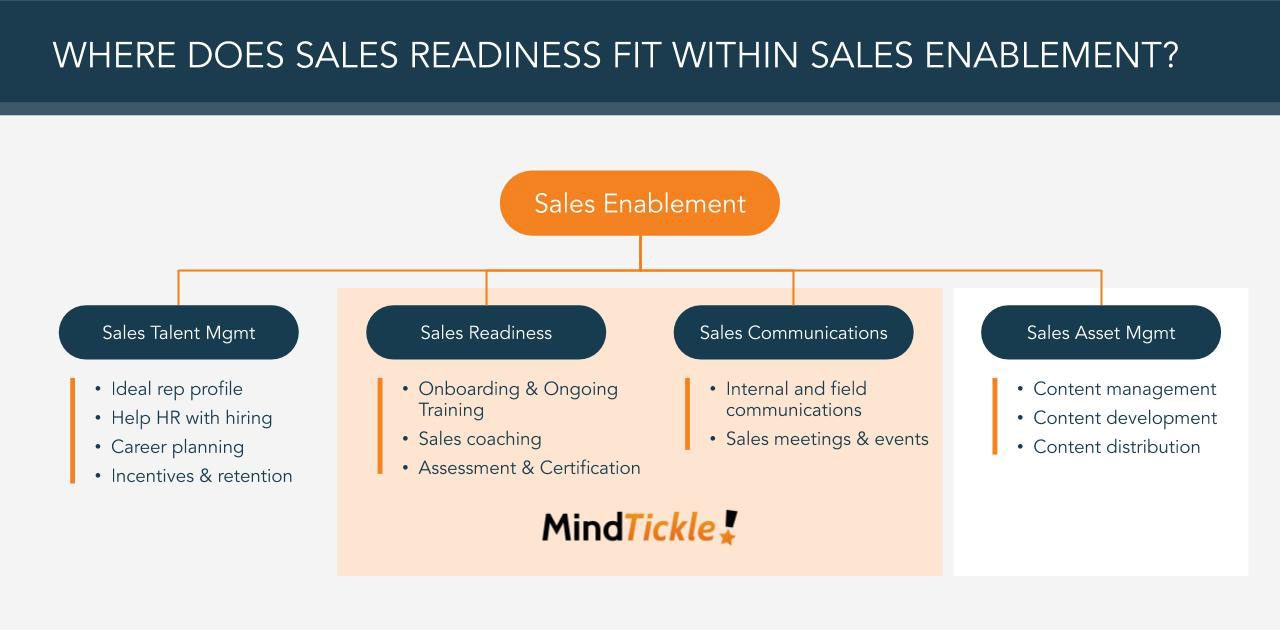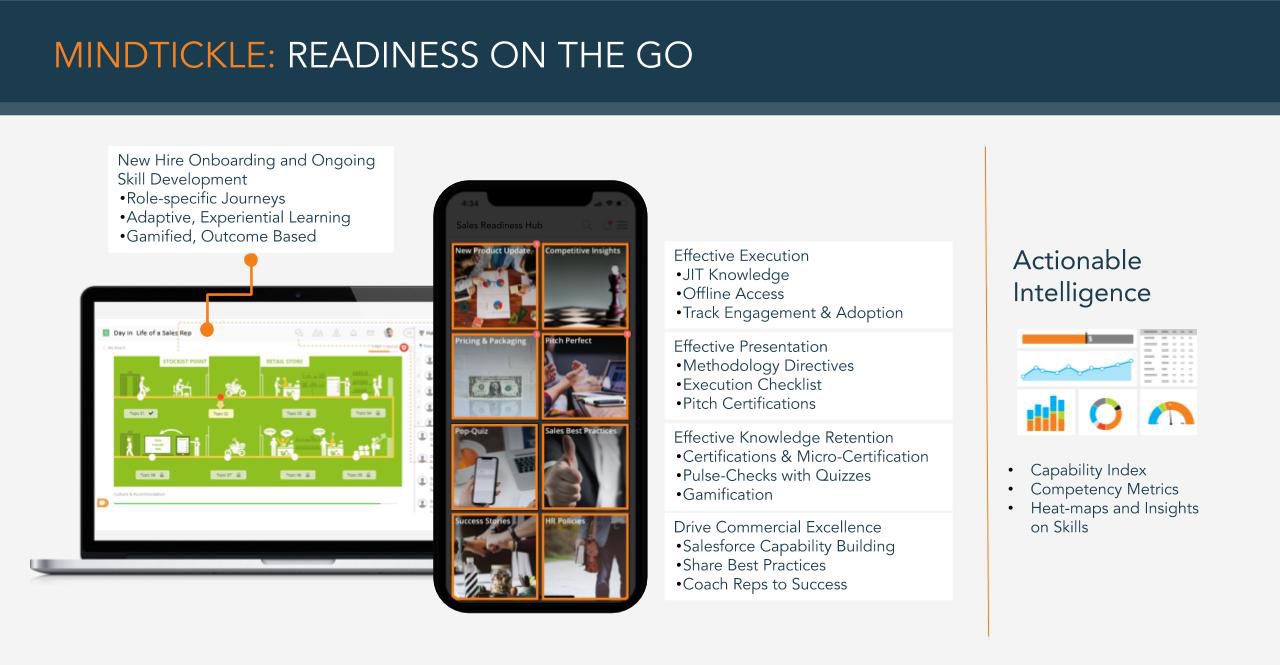The sales environment is constantly evolving as new strategies, markets, and products are introduced, reintroduced, or changed. In fact, according to a study of over 100 B2B organizations, 75% of firms have a refocused sales strategy, 70% have entered a new market, and 82% introduced a new product or service over the past twelve months.
In fact, according to a study of over 100 B2B organizations, 75% of firms have a refocused sales strategy, 70% have entered a new market, and 82% introduced a new product or service over the past twelve months.
With the sales function constantly evolving, it’s critical for sales teams to have up-to-date support and the tools they need to sell. This is where data driven sales enablement comes in.

Sales enablement is the strategy you use to ensure sales reps have the information, content, technology, and tools they need to sell effectively. An integral part of your overall sales readiness program, sales enablement focuses on providing everything your reps need to be successful, at every step of the sales journey. When you incorporate elements of sales training, asset management, ongoing coaching, and continuous development—all in a platform that supports a variety of content formats and learning styles—the results are amazing:
The 2019 State of Sales Enablement Report 2019 found that organizations who employ an effective sales enablement strategy:
- Achieve a win rate of 49% on average, which is 12% higher than those without an enablement strategy.
- Hit their quotas 35% more often than those without a formal sales enablement strategy.
- Experience 15% less turnover than those that approach sales enablement as one-off projects.
- Collaboration is twice as likely within organizations that use a formal sales enablement strategy vs. those that use an informal or one-time initiative.
But while 61% of organizations employ some type of sales enablement program, only 34.4% feel it meets their expectations. That number has only improved by a small margin, about 3%, over the past few years. Choosing the right enablement program with intuitive tools is just as critical as not having one at all.
So, why are most organizations struggling when it comes to sales enablement?
Perhaps the topic is misunderstood as a whole—as a one-time project that, once complete, results in a new and improved sales function. Rather, sales enablement must be an ongoing initiative that involves content, training, coaching, and performance measurement.
Sales enablement as part of your readiness strategy can have a significant impact on an organization’s bottom line. 52% of sales organizations who have a specific sales enablement function claim overall sales training effectiveness 29% higher than those who don’t. A sales enablement strategy makes it easy to gauge sales readiness with continuous, accessible training, trackable performance and outcome measures, and a modern approach geared for improved results.
52% of sales organizations who have a specific sales enablement function claim overall sales training effectiveness 29% higher than those who don’t.
There’s myriad data that demonstrates just how valuable a successful sales enablement strategy can be in driving revenue. And understanding what to do with those stats can help you build a better sales enablement program and overall environment for your sales teams. Whether you’ve yet to implement a sales enablement strategy or are looking to make improvements to your existing program, these statistics should be used to inform your next steps.
Sales and Marketing Alignment
A key best practice for any sales enablement strategy requires sales and marketing teams to work in harmony. Sales and morale suffer when knowledge isn’t routinely shared. That becomes a significant challenge for departments operating under differing definitions of the market or specific products.
It’s a foregone conclusion that the two teams should be aligned, but is often not the case. In fact, only 8% of marketing and sales teams of B2B companies say they experience strong alignment.
These two unique areas may have different roles, but should share the same goals and a clear roadmap that leads to them. So how can sales enablement turn the tables?
- Debunk long-held beliefs within a company’s culture that sales and marketing are separate entities.
- Demonstrate buy-in by leadership and build an open, collaborative relationship between the two departments.
- Establish a modern marketing department that drives revenue, just like sales.
Sales and Marketing Alignment: Key Stats
Why does sales and marketing alignment matter? Here’s what the data show:
- 36% higher customer retention rates and 38% higher overall sales wins are reported by marketing- and sales-aligned companies.
- Over 75% of companies that use a sales enablement tool saw a sales increase over twelve months. 40% of those organizations reported growth over 25%.
- 74% of high-performing organizations have strong sales and marketing alignment.
- 59% of companies with established sales enablement functions surpassed revenue targets, and 72% of those exceeded them by 25% or more.
Making up-to-date content available to sales reps is a crucial part of sales and marketing alignment. Here’s how content management affects the sales team:
- On average, only 47% of salespeople feel they are provided with relevant and effective content. Either they don’t know what’s available, or they don’t have the time or resources to seek it.
- 57% of businesses say high-quality content is their top driver of sales. Sales reps shouldn’t have to make their own content. Sales enablement ensures sales and marketing are working closely together to provide up-to-date, valuable content and collateral specific to each customer.
- 60% of quality sales content goes unused, without a good process for distribution. That means wasted time and resources that could otherwise help drive the sales initiatives.
- Just 20% of sales reps use content during a sales conversation, yet, a buyer usually requires touching more than five pieces of content before making a purchase.
- Over $2.3 million are lost yearly by organizations that either didn’t use or underused marketing content.
Sales Onboarding & Training
First impressions are crucial. Successful sales reps require education, and undertrained reps can cause irreparable damage to customer relationships and sales.
A sales enablement strategy should include an effective onboarding program that ensures new hire progress and performance is measured, supported, and consistently improved upon based on firm metrics to enhance your organization’s readiness.
Sales-specific onboarding provides new hires with information about company values, corporate and product knowledge, and how to use company tools to improve quotas. The most successful onboarding programs help reps learn with smaller, easy to digest modules, clear objectives, and accessible materials.
Sales Onboarding & Training: Key Stats
A poorly trained rep is not equipped to sell, and may not choose to stay with your organization. That’s revenue lost on two counts: loss of sales, and cost of onboarding. Maybe it’s not the rep that isn’t prepared, but instead, materials used for training aren’t up to the task. Sales enablement provides tracking and options for each sales rep to achieve their best outcomes.
Here’s how proper onboarding affects overall performance and success:
- Training improves retention rates for new hires and products with an early, effective, onboarding information: The best companies are 53% more likely to undertake pre-boarding and begin onboarding early, often before the first day.
- Most companies feel their onboarding efforts are subpar: 62% of companies consider themselves ineffective at onboarding new sales hires, despite leadership with an eye one sales enablement.
- Employee turnover is expensive: The average economic cost of turning over a highly skilled job is over two times the salary of that role. 20% of staff turnover takes place in the first 45 days of employment.
Sales Efficiency
It’s easier to access the numbers associated with your organization’s revenue than to know what it’s actually costing to get your sales team up to speed and keep them there. The relation between those two things is sales efficiency. It includes the important task of streamlining sales operations to produce the highest return on investment.
That’s where an effective sales enablement strategy ups the game. It enables your team to implement a consistent measure of those numbers over time and ensure your organization stays profitable. Insight from specific metrics provided by sales enablement helps a business develop and evolve overall strategy, sales training, product direction, and even qualified leads.
Sales Efficiency: Key Stats
These data points demonstrate just how essential sales enablement is for the efficiency of your reps:
- 84% of sales reps can achieve quotas when their employer engages the best sales enablement strategies available.
- Quota attainment was doubled among companies that adopted best practices for sales enablement, compared to those that did not.
- 59% of companies surpassed yearly revenue targets as a result of a well-defined sales enablement strategy.
- 65% of B2B organizations count sales productivity as their greatest challenge.
Sales Enablement Technology
Software that allows easy access to a sales enablement strategy and tools seamlessly connects operations, marketing, and sales. Sales enablement technology improves onboarding, coaching, and ongoing training by delivering engaging content in a measurable platform that can track progress.
Technology-based sales enablement solutions help sales reps learn new skills, improve existing skills, and track progress toward development goals. The right sales enablement technology offers:
- Automation: Data feeds, updates, and integration solutions for software like Salesforce, Excel, and industry-specific sources.
- Customer insight: Customer details are tracked and accessible while reps are in the field. Make account updates. Note specific sales or company requests.
- Rapid mobile access: No need to get back to a customer later with more information — account and product information is available via mobile devices, fast tracking answers to customer questions with actual company marketing or sell information.
- Analytics: Users and managers can choose onboarding and learning materials relevant to individual needs. Outcome metrics about which tools are used most often with the best results help predict the best resources for the future.
- Real-time updates: Collateral materials are automatically updated and available immediately. Relevant content is available to sales teams upon request, and product line information can be organized according to customer, location, or other specifics.


Sales Enablement Technology: Key Stats
The numbers prove how just how imperative technology has become among sales initiatives:
- The use of AI is forecasted to grow 139% by 2022 as top sales teams use AI to create effective customer experiences.
- 86% of sales managers believe the use of digital tools improves job performance. The opportunity to use mobile devices in the field allows easy access to those tools and can be used to significantly enhance the sales process, providing access to remote customer data, a CRM platform, continually relevant information, and the ability to complete menial tasks on the run.
- Technology makes any environment a functional learning opportunity with continuous access to video, role-play opportunities, and even digital social learning environments.
Your Future with Sales Enablement
Choosing a sales enablement solution is a personal journey for your organization on the path to overall readiness. Consider a technology platform that balances your specific needs for marketing and sales collaboration, content management, sales onboarding and training, and a convenient, relevant use of automation.
Review MindTIckle’s Readiness Value Assessment to determine how sales enablement can contribute to your ROI. Or schedule a demo to see the Mindtickle Sales Readiness Platform in action today!







